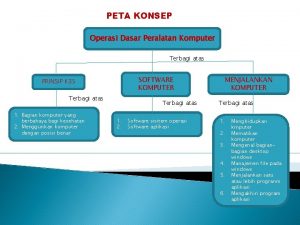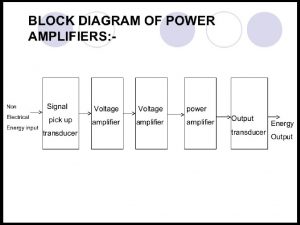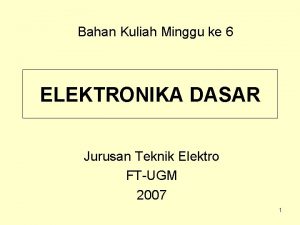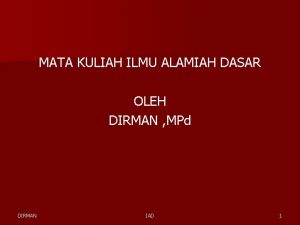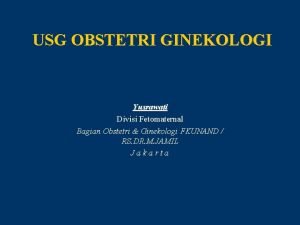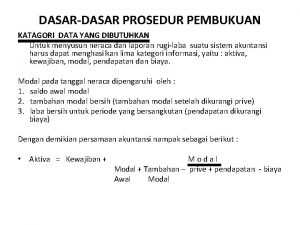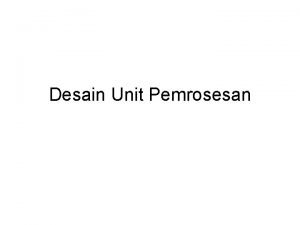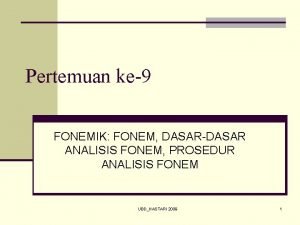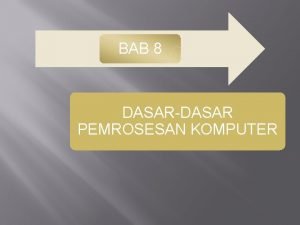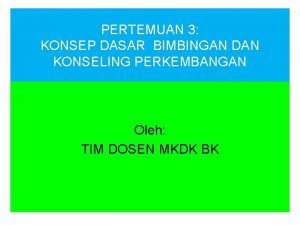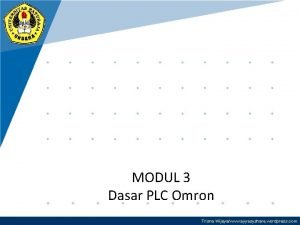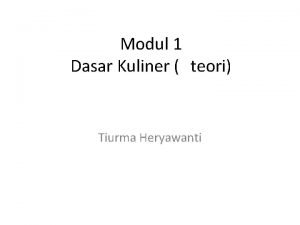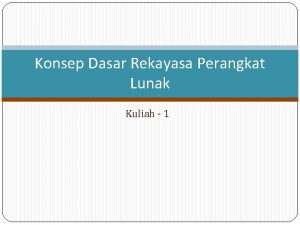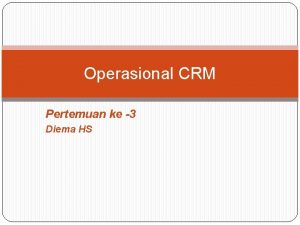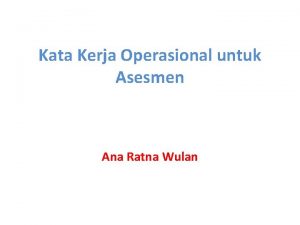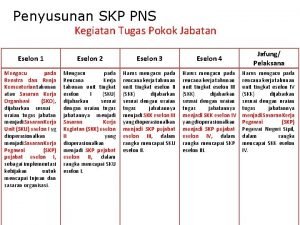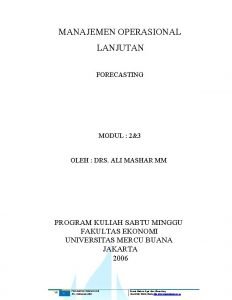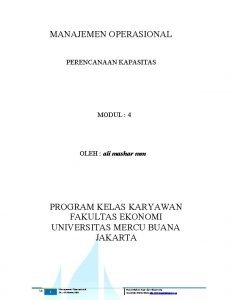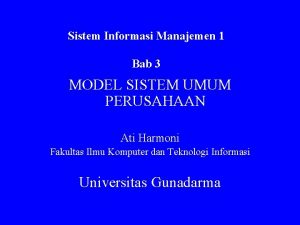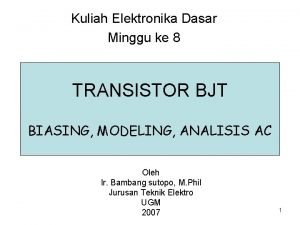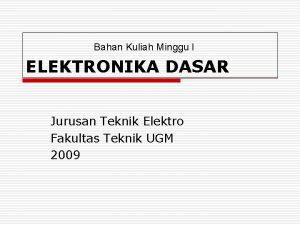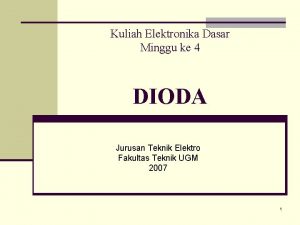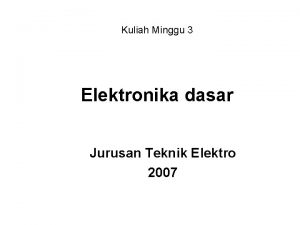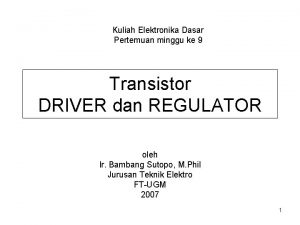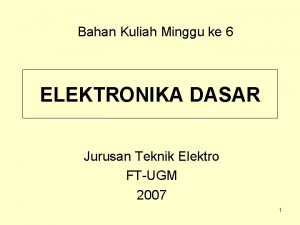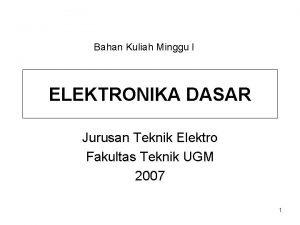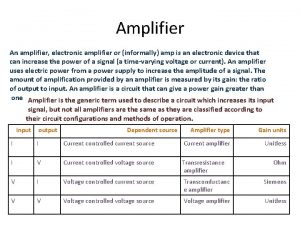KULIAH MINGGU ke 2 Elektronika Dasar OPERASIONAL AMPLIFIER












































































- Slides: 76

KULIAH MINGGU ke 2 Elektronika Dasar OPERASIONAL AMPLIFIER OP-AMP Jurusan Teknik Elektro 2007 1

Op-amp : suatu IC analog + VCC Input 1 + Input 2 output _ - VEE SIMBOL 2

SIFAT IDEAL Ideally, 1. No current can enter terminals V+ or V-. Called infinite input impedance. A 2. Vout=A(V+ - V-) with A → ∞ 3. In a circuit VOUT = (AV+ - AV ) = A (V+ - V ) V+ is forced equal to V- 4. An opamp needs two voltages to power it Vcc and -Vee. 3 -

Operational Amplifier (Op Amp) Vi 1 Vi 2 A B + Vout An operational amplifier (Op Amp) is an integrated circuit of a complete amplifier circuit. Op amps have an extremely high gain (A=105 typically). Op amps also have a high input impedance (R=4 MΩ , typically) and a low output impedance (in order of 100 Ω , typically). 4

Characters of Operational Amplifiers Not used 8 7 6 5 Offset null § high open loop gain § high input impedance § low output impedance § low input offset voltage § Offset null 1 2 3 4 low temperature coefficient of input offset voltage § low input bias current § wide bandwidth § large common mode rejection ratio (CMRR) 5

Voltage Output from an Amplifier The linear range of an amplifier is finite, and limited by the supply voltage and the characteristics of the amplifier. Vout A Non-linear region Linear region Vin= V 2 -V 1 Daerah Linier ini sangat Kecil Vin If an amplifier is driven beyond the linear range (overdriven), serious errors can result if the gain is treated as a constant. Kalau A = 106 dan VCC = 12 Volt maka daerah linier = 24 μV 6

OPAMP: COMPARATOR (bekerja di daerah jenuh) Vout=A(Vin – Vref) A If Vin>Vref, Vout = +∞ but practically hits +ve power supply = Vcc A (gain) very high If Vin<Vref, Vout = -∞ but practically hits –ve power supply = -Vee Application: detection of a complex signal in ECG VREF VIN Vcc Vout -Vee 7

OPAMP: ANALYSIS The key to op amp analysis is simple 1. No current can enter op amp input terminals. => Because of infinite input impedance 2. The +ve and –ve (non-inverting and inverting) inputs are forced to be at the same potential. => Because of infinite open loop gain 3. Use the ideal op amp property in all your analysis 8

Inverting Amplifier (bekerja di daerah linier) Point B is grounded, point A is called Virtual Grounded. RF R 1 Vin A B Voltage across R 1 is Vin, and across RF is Vout. + Vout The output node voltage determined by Kirchhoff's Current Law (KCL). Circuit voltage gain determined by the ratio of R 1 and RF. 9

PENGUAT INVERTING (bekerja di daerah linier) Kondisi fisik R 1 R 3 1 8 2 7 3 6 4 5 R 2 output input 10

OPAMP: INVERTING AMPLIFIER 1. V- = V+ 2. As V+ = 0, V- = 0 (VG) 3. As no current can enter V- and from Kirchoff’s Ist law, I 1=I 2. 4. I 1 = (VIN - V-)/R 1 = VIN/R 1 5. I 2 = (0 - VOUT)/R 2 = -VOUT/R 2 => VOUT = -I 2 R 2 6. From 3 and 6, VOUT = -I 2 R 2 = -I 1 R 2 = -VINR 2/R 1 (NEG) 7. Therefore VOUT = (-R 2/R 1)VIN 11

Analysis of Inverting Amplifier RF KCL at A: i. F VIN Vin R 1 i 1 - i-A i+ B + Vout R Ideal transfer characteristics: or 12

OPAMP: NON – INVERTING AMPLIFIER (bekerja di daerah linier) 1. V- = V+ 2. As V+ = VIN, V- = VIN Vx 3. As no current can enter V- and from Kirchoff’s Ist law, I 1=I 2. 4. I 1 = Vx/R 1=VIN/R 1 5. I 2 = (VOUT - VIN)/R 2 VOUT = VIN + I 2 R 2 6. VOUT = I 1 R 1 + I 2 R 2 = (R 1+R 2)I 1 = (R 1+R 2)VIN/R 1 7. Therefore VOUT = (1 + R 2/R 1)VIN (tak berlawanan) 13

Noninverting Amplifier Point VA equals to Vin. RF Op-amp circuit is a voltage divider. R 1 A Vin B + Vout Circuit voltage gain determined by the ratio of R 1 and RF. 14

OPAMP : VOLTAGE FOLLOWER (BUFER) (bekerja di daerah linier) i=0 V+ = VIN. V- = V + Thus Vout = V- = V+ = VIN !!!! So what’s the point ? The point is, due to the infinite input impedance of an op amp, no current at all can be drawn from the circuit before VIN. Thus this part is effectively isolated. Very useful for interfacing to high impedance sensors such as microelectrode, microphone… 15

Differential Amplifier RF V 1 V 2 Point B is grounded, so does point A (very small). R 1 A R 2 B R 3 + Vout Voltage across R 1 is V 1, and across R 2 is V 2. Normally: R 1 = R 2, and RF = R 3. Commonly used as a single op-amp instrumentation amplifier. 16

Analysis of an Instrumentation Amplifier Design a single op-amp instrumentation amplifier. R 1 = R 2, R F = R 3 Determine the instrumentation gain. RF R 1 V 2 A - R 2 B + Vout R 3 17

SUMMING AMPLIFIER If Recall inverting amplifier and = I 1 + I 2 + … + I n If VOUT = -Rf (V 1/R 1 + V 2/R 2 + … + Vn/Rn) Summing amplifier is a good example of analog circuits serving as analog computing amplifiers (analog computers)! Note: analog circuits can add, subtract, multiply/divide (using logarithmic components, differentiat and integrate – in real time and continuously. 18

For the following circuit, calculate the input resistance. Vin R 1 Rf Vout R 2 19

INSTRUMENTATION AMPLIFIER 20

INSTRUMENTATION AMPLIFIER Inverting Gain in the multiple stages: i. e. High Gain – so, you can amplify small signals amplifier very high input impedance - So, you can connect to sensors Differential amplifier -> it rejects common-mode interference -> so you can reject noise Non-inverting amplifier 21

INSTRUMENTATION AMPLIFIER: STAGE 1 Recall virtual ground of opamps I 1 = (V 1 – V 2)/R 1 I 1 I 1 I 2 I 3 Recall no current can enter opamps and Kirchoff’s current law I 2 = I 3 = I 1 Recall Kirchoff’s voltage law VOUT = (R 1 + 2 R 2)(V 1 – V 2)/R 1 = (V 1 – V 2)(1+2 R 2/R 1) 22

INSTRUMENTATION AMPLIFIER: STAGE 2 Recall virtual ground of opamps and voltage divider V- = V+ = VBR 4/(R 3 + R 4) VA VB I 1 I 2 I 3 Recall no current can enter opamps (VA – V-)/R 3 = (V- – VOUT)/R 4 Solving, VOUT = – (VA – VB)R 4/R 3 23

INSTRUMENTATION AMPLIFIER: COMPLETE VOUT = – (V 1 – V 2)(1 + 2 R 2/R 1)(R 4/R 3) 24

Analog Signal Conditioner (Current to Voltage Converter, LM-324) +5 VDC Sensor – Variable Resistor 4. 7 k I 1 10 k I 2 10 k I 3 5 k Vout 0 -5 VDC As force is applied on the sensor, the value of the variable resistor changes which results in a specific voltage output. Gain = Vout/Vin = 1 Resistor Values for the Inverting OP-Amp can be changed to modify gain of converter or to amplify the signal of interest. 25

Single-Ended Input • + terminal : Source • – terminal : Ground • 0 o phase change • + terminal : Ground • – terminal : Source • 180 o phase change Ref: 080114 HKN Operational Amplifier 26

Double-Ended Input • Differential input • • 0 o phase shift change between Vo and Vd Qu: What Vo should be if, Ans: (A or B) ? (A) Ref: 080114 HKN Operational Amplifier (B) 27

Distortion The output voltage never excess the DC voltage supply of the Op-Amp Ref: 080114 HKN Operational Amplifier 28

Common-Mode Operation • Same voltage source is applied at both terminals • Ideally, two input are equally amplified • Output voltage is ideally zero due to differential voltage is zero • Practically, a small output signal can still be measured Note for differential circuits: Opposite inputs : highly amplified Common inputs : slightly amplified Common-Mode Rejection Ref: 080114 HKN Operational Amplifier 29

Common-Mode Rejection Ratio (CMRR) Differential voltage input : Common-mode rejection ratio: Output voltage : Gd : Differential gain Gc : Common mode gain Ref: 080114 HKN Note: When Gd >> Gc or CMRR V o = Gd V d Operational Amplifier 30

CMRR Example What is the CMRR? Solution : (1) (2) NB: This method is Not work! Why? Ref: 080114 HKN Operational Amplifier 31

Op-Amp Properties (1) Infinite Open Loop gain - The gain without feedback Equal to differential gain Zero common-mode gain Pratically, Gd = 20, 000 to 200, 000 (2) Infinite Input impedance - Input current ii ~0 A T- in high-grade op-amp m-A input current in low-grade op-amp (3) Zero Output Impedance - Ref: 080114 HKN act as perfect internal voltage source No internal resistance Output impedance in series with load Reducing output voltage to the load Practically, Rout ~ 20 -100 Operational Amplifier 32

Frequency-Gain Relation • • • Ideally, signals are amplified from DC to the highest AC frequency Practically, bandwidth is limited 741 family op-amp have an limit bandwidth of few KHz. 20 log(0. 707)=3 d. B Unity Gain frequency f 1: the gain at unity Cutoff frequency fc: the gain drop by 3 d. B from dc gain Gd GB Product : f 1 = Gd fc Ref: 080114 HKN Operational Amplifier 33

GB Product Example: Determine the cutoff frequency of an op-amp having a unit gain frequency f 1 = 10 MHz and voltage differential gain Gd = 20 V/m. V Sol: ? Hz Since f 1 = 10 MHz By using GB production equation f 1 = Gd f c fc = f 1 / Gd = 10 MHz / 20 V/m. V 10 MHz = 10 106 / 20 103 = 500 Hz Ref: 080114 HKN Operational Amplifier 34

Ideal Vs Practical Op-Amp Ideal Practical Open Loop gain A 105 Bandwidth BW 10 -100 Hz Input Impedance Zin >1 M 0 10 -100 Output Impedance Zout Output Voltage Vout CMRR Ref: 080114 HKN Depends only on Vd = (V+ V ) Differential mode signal Depends slightly on average input Vc = (V++V )/2 Common-Mode signal 10 -100 d. B Operational Amplifier 35

Ideal Op-Amp Applications Analysis Method : Two ideal Op-Amp Properties: (1) The voltage between V+ and V is zero V+ = V (2) The current into both V+ and V termainals is zero For ideal Op-Amp circuit: (1) Write the kirchhoff node equation at the noninverting terminal V+ (2) Write the kirchhoff node eqaution at the inverting terminal V (3) Set V+ = V and solve for the desired closed-loop gain Ref: 080114 HKN Operational Amplifier 36

Noninverting Amplifier (1) Kirchhoff node equation at V+ yields, (2) Kirchhoff node equation at V yields, (3) Setting V+ = V– yields or Ref: 080114 HKN Operational Amplifier 37

Noninverting amplifier Voltage follower Ref: 080114 HKN Noninverting input with voltage divider Less than unity gain Operational Amplifier 38

Inverting Amplifier (1) Kirchhoff node equation at V+ yields, (2) Kirchhoff node equation at V yields, (3) Setting V+ = V– yields Ref: 080114 HKN Notice: The closed-loop gain Vo/Vin is dependent upon the ratio of two resistors, and is independent of the open-loop gain. This is caused by the use of feedback output voltage to subtract from the input voltage. Operational Amplifier 39

Multiple Inputs (1) Kirchhoff node equation at V+ yields, (2) Kirchhoff node equation at V yields, (3) Setting V+ = V– yields Ref: 080114 HKN Operational Amplifier 40

Inverting Integrator Now replace resistors Ra and Rf by complex components Za and Zf, respectively, therefore Supposing (i) The feedback component is a capacitor C, i. e. , (ii) The input component is a resistor R, Za = R Therefore, the closed-loop gain (Vo/Vin) become: where What happens if Za = 1/j C whereas, Zf = R? Inverting differentiator Ref: 080114 HKN Operational Amplifier 41

Example: Op-Amp Integrator (a) Determine the rate of change of the output voltage. (b) Draw the output waveform. Solution: (a) Rate of change of the output voltage (b) In 100 s, the voltage decrease Ref: 080114 HKN Operational Amplifier 42

Op-Amp Differentiator Ref: 080114 HKN Operational Amplifier 43

Non-ideal case (Inverting Amplifier) Equivalent Circuit 3 categories are considering q Close-Loop Voltage Gain q Input impedance q Output impedance Ref: 080114 HKN Operational Amplifier 44

Close-Loop Gain Applied KCL at V– terminal, By using the open loop gain, The Close-Loop Gain, Av Ref: 080114 HKN Operational Amplifier 45

Close-Loop Gain When the open loop gain is very large, the above equation become, Note : The close-loop gain now reduce to the same form as an ideal case Ref: 080114 HKN Operational Amplifier 46

Input Impedance can be regarded as, where R is the equivalent impedance of the red box circuit, that is However, with the below circuit, Ref: 080114 HKN Operational Amplifier 47

Input Impedance Finally, we find the input impedance as, Since, , Rin become, Again with Note: The op-amp can provide an impedance isolated from input to output Ref: 080114 HKN Operational Amplifier 48

Output Impedance Only source-free output impedance would be considered, i. e. Vi is assumed to be 0 Firstly, with figure (a), By using KCL, io = i 1+ i 2 By substitute the equation from Fig. (a), R and A comparably large, Ref: 080114 HKN Operational Amplifier 49

KOMPARATOR n n Rangkaian komparator digunakan untuk membandingkan tegangan masukan dan tegangan referensi. Tegangan keluaran hanya ada dua kondisi yaitu tegangan tinggi atau rendah (negatif). Kondisi ini ditentukan oleh besarnya tegangan masukan apakah lebih tinggi terhadap tegangan referensi atau lebih rendah. Persoalan dalam komparator sederhana adalah stabilitas. Bila tegangan masukan bervariasi sekitar tegangan referensi maka tegangan keluaran akan berubah-ubah tidak stabil. Hal tersebut dapat dihilangkan dengan rangkaian schmitt. 50

KOMPARATOR SEDERHANA 51

KURVA HUBUNGAN TEGANGAN Vr>0 Vi < Vr Vi > Vr Vo = +Vsat Vo = -Vsat 52

KURVA HUBUNGAN TEGANGAN Vo Vr=0 Vi Vi < Vr Vi > Vr Vo = +Vsat Vo = -Vsat 53

KURVA HUBUNGAN TEGANGAN Vo Vr<0 Vi Vi < Vr Vi > Vr Vo = +Vsat Vo = -Vsat 54

STABILITAS KOMPARATOR SEDERHANA Vcc Vin VCC/2 Teganga n masukan R Vcc/2 R Tegangan keluaran 55

RANGKAIAN SCHMITT Positive Feedback Vin Vout /2 R R Rangkaian ini disebut komparator Schmitt trigger. Rangkaian resistor membuat positive feedback. 56

CARA KERJA Schmitt trigger Vin Vout /2 R R Anggap tegangan masukan kecil, tegangan keluaran menjadi tinggi. Bila Vout is 4 V, maka masukan non-inverting V+ adalah 2 Volt. Kondisi keluaran tetap selama Vin kurang dari 2 Volt. Bila Vin diperbesar sehingga lebih besar dari 2 V, maka Vout akan nol, dan V+ akan nol juga. Kondisi output ini akan tetap, selama Vin lebih besar 2 V. 57

TAK STABIL 58

STABIL histerisis 59

STABIL 60

STABIL 61

RANGKAIAN dan OUTPUT 62

KETERANGAN SCHMITT n n Schmitt trigger adalah sebuah aplikasi comparator yang mengubah tagangan keluaran menjadi negatif bila mtegangan masukan lebih besar tegangan referensi. Kemudian menggunakan negative feedback untuk mencegah agar tegangan keluaran tdk kembali ke kondisi semula saat tegangan kembali kurang dari tegangan referensi, sampai nanti masukan lebih kecil dari yang ditentukan. 63

A P L I K A S I 64

PERHITUNGAN n Kerja Schmitt trigger merupakan proses komparasi dengan threshold ganda. Persamaan arus di titik A: n Karena hanya 2 pers, maka harus ada satu R yang ditentukan dulu. Ingat : Vout = VCC saat Vin diatas batas (V 2) Vout = -VEE saat Vin dibawah batas bawah (V 2’). 65

u 66

LM 741 67

NOMOR KAKI 68

69

70

71

72

73

74

KESIMPULAN Op-amp dapat digunakan sebagai : 1. 2. 3. 4. 5. 6. Penguat INVERTING Penguat NON INVERTING BUFER Penguat PENJUMLAH Penguat INSTRUMENTASI Pengubah ARUS KE TEGANGAN atau sebaliknya 7. KOMPARATOR 75

PR • Buktikan rumus untuk menghitung R 1, R 2 dan R 3 pada komparator Schmitt (slide 41), bila batas dan batas bawah diketahui. • Rencanakanlah sebuah komparator Schmitt dengan menggunakan sebuah op-amp, yang menggunakan single supply 5 Volt. Batas tegangan yang dideteksi adalah diatas 3 Volt memberikan tegangan output tinggi, dan dibawah 1 Volt menghasilkan tegangan output rendah. Tentukan nilai R yang diperlukan. 76
 Peta konsep perangkat keras komputer
Peta konsep perangkat keras komputer Difference between voltage and current
Difference between voltage and current Kata pengantar ktsp paud
Kata pengantar ktsp paud Elektronika dasar 1
Elektronika dasar 1 Komponen elektronika daya
Komponen elektronika daya Materi statistika dasar kuliah
Materi statistika dasar kuliah Materi kuliah ilmu alamiah dasar semester 1
Materi kuliah ilmu alamiah dasar semester 1 Mata kuliah ilmu alamiah dasar
Mata kuliah ilmu alamiah dasar Energi
Energi Kebaktian sekolah minggu
Kebaktian sekolah minggu Michael jackson ocd
Michael jackson ocd Pengakuan iman rasuli hkbp
Pengakuan iman rasuli hkbp Cara menjadi guru sekolah minggu
Cara menjadi guru sekolah minggu Ocd 2 minggu
Ocd 2 minggu Minggu rogate
Minggu rogate Foto usg 8 minggu
Foto usg 8 minggu Jadual waktu kssr semakan 2017
Jadual waktu kssr semakan 2017 Ocd obsessive thoughts
Ocd obsessive thoughts Element bounding attachment
Element bounding attachment Yeremia 17 : 5 - 10
Yeremia 17 : 5 - 10 Metafasis
Metafasis Contoh kempen membaca
Contoh kempen membaca Dr emily o'leary
Dr emily o'leary Typography minggu
Typography minggu Syair hari minggu
Syair hari minggu Ocd 2 minggu
Ocd 2 minggu Indonesia, tanah airku tanah tumpah darahku
Indonesia, tanah airku tanah tumpah darahku Dasar dasar prosedur pembukuan
Dasar dasar prosedur pembukuan Operasi dasar komputer
Operasi dasar komputer Dasar dasar pembukuan
Dasar dasar pembukuan Pengertian pengorganisasian dan pengembangan masyarakat
Pengertian pengorganisasian dan pengembangan masyarakat Memahami pengetahuan dasar konsep desain jaringan
Memahami pengetahuan dasar konsep desain jaringan Konsep dasar unit pemrosesan dan dasar datapath
Konsep dasar unit pemrosesan dan dasar datapath Faktor pembentuk kelompok sosial
Faktor pembentuk kelompok sosial Dasar dasar pengujian perangkat lunak
Dasar dasar pengujian perangkat lunak Pertanyaan dasar dasar korespondensi bisnis
Pertanyaan dasar dasar korespondensi bisnis Analisis fonem
Analisis fonem Dasar dasar manajemen
Dasar dasar manajemen Dasar dasar pemrosesan komputer
Dasar dasar pemrosesan komputer Pengukuran dan teori ketidakpastian
Pengukuran dan teori ketidakpastian Dasar-dasar komunikasi dalam pembelajaran
Dasar-dasar komunikasi dalam pembelajaran Datapath
Datapath Dasar dasar korespondensi bisnis
Dasar dasar korespondensi bisnis Konsep bimbingan dan konseling
Konsep bimbingan dan konseling Etika desain
Etika desain Plc omron
Plc omron Konsep dasar advokasi kesehatan
Konsep dasar advokasi kesehatan Dasar dasar kuliner
Dasar dasar kuliner Materi dasar-dasar agronomi ipb
Materi dasar-dasar agronomi ipb 5 dasar pelaksanaan kokurikulum
5 dasar pelaksanaan kokurikulum Basic engineering process
Basic engineering process Dasar dasar pengambilan keputusan menurut george r terry
Dasar dasar pengambilan keputusan menurut george r terry Dasar dasar manajemen
Dasar dasar manajemen Dasar dasar penelitian sejarah
Dasar dasar penelitian sejarah Etika relasi karyawan dan perlakuan adil di tempat kerja
Etika relasi karyawan dan perlakuan adil di tempat kerja Operasionalisasi variabel penelitian
Operasionalisasi variabel penelitian Rencana spesifik dan direktif
Rencana spesifik dan direktif Pedoman operasional penilaian angka kredit
Pedoman operasional penilaian angka kredit Tata letak berorientasi proses
Tata letak berorientasi proses Pohon keputusan manajemen operasional
Pohon keputusan manajemen operasional Contoh operasionalisasi variabel
Contoh operasionalisasi variabel Contoh falsafah perusahaan
Contoh falsafah perusahaan Ciri ciri riset operasi
Ciri ciri riset operasi Crm operasional adalah
Crm operasional adalah Kata kerja menemukan
Kata kerja menemukan Aspek operasional dalam bisnis
Aspek operasional dalam bisnis Kegiatan tugas jabatan
Kegiatan tugas jabatan Pengertian pengendalian operasional
Pengertian pengendalian operasional Manajemen operasional
Manajemen operasional Contoh aspek operasional
Contoh aspek operasional Manajemen operasional lanjutan
Manajemen operasional lanjutan Logo penilaian
Logo penilaian Standar operasional manajemen koperasi
Standar operasional manajemen koperasi Fungsi manajemen operasional pada perencanaan kapasitas
Fungsi manajemen operasional pada perencanaan kapasitas Model sistem informasi manajemen
Model sistem informasi manajemen Makalah sistem operasional bank syariah
Makalah sistem operasional bank syariah Definisi operasional dan kriteria objektif
Definisi operasional dan kriteria objektif
